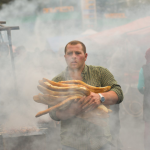Mtsvadi – a skewered meat is not a surprise. Considering cultural and religious backgrounds, you can find its variations in almost every country in the world. Kakheti, and mountainous regions of Georgia are famous for Mtsvadi.
Everyone loves Mtsvadi. It is not just food or dish; it is the gem of Georgian cuisine, a signature of the Georgian cuisine.
What makes it so special?
Like I said, meat on a skewer is not a surprise. The idea of authenticity lays in its technique, nature, and environment of Mtsvadaoba a.k.a making of Mtsvadi.
Salt is in the simplicity of the dish, joy of gatherings around the fire, chatting, and waiting for the magic to happen.
Visiting a friend or relative in Kakheti? You are making Mtsvadi.
And you can always find a reason to visit Kakheti and eat Mtsvadi.
The most outstanding occasions of Mtsvadaoba are the New Year, Christmas, vintage, and making of vodka (Zaodoba).
My grandparents always had pigs. They bred them all through the year and then, for the New Year, there was a pig slaughtering, called “Pig Funeral” in Georgian [Ghoris Kelekhi].
What an occasion!
Close family members attend the Pig Funeral. Others are by invitation only. Doors open in the early morning. They bathe, clean, and slaughter the pig.
Afterward, they cook the first fresh parts right there, for the funeral.
Moreover, these parts are very special, and the host family treats only special people. So, if they invite you for this occasion, you are the chosen one. You are privileged.
Mtsvadi is skewered on the fire made of vine brush. In Kakheti, after pruning the vine, people chop the vine brush, pile them up and keep them in backyards. They use them for heating up Tone and making fire for Mtsvadi. Vine brush fire and smoke are very specific that gives Mtsvadi its authentic flavor.
Apart from pork, people also skewer lamb, beef, and venison. The latter is mostly characterized by the mountainous regions, namely, deer, wild mountain goats. I have never tried it. Thus, any hard endeavor of making Mtsvadi indoors is just an endeavor. Remember, Mtsvadi made on the pan, on the grill, or whatsoever is not Mtsvadi, it is roasted meat simply!
Of course, the proper brush fire, proper slices, salting, and sense of time while turning the skewers on fire are the key factors to the magnificent bouquet of aromas and flavors. That is why good Mtsvadi cooks are rare.
After Mtsvadi is ready, you have to make final accords. You have fresh baked Shotis Puri there, and you are removing the slices from the skewer with this Georgian bread. Therefore, If you earn this magic slice, you can proudly sing “We are the champions” or if you are so lucky, you can even hear some Georgian polyphonic song.
My Kakhetian grandfather used to say “Good Mtsvadi does not need any additional sauce”, where he meant plum sauce, tomato sauce, etc.
When all the slices are in a bowl, you squeeze pomegranate over it and cover it with a plate or another bowl. This is the most exciting moment for me. I’ve been waiting for this moment for the whole day, I worked, I longed and I loved it. It feels like drops of pomegranate come like tears from my eyes.
And finally, with a hot bowl in your hands, you are rushing towards the table, where everyone extremely and eagerly is waiting for Mtsvadi.




